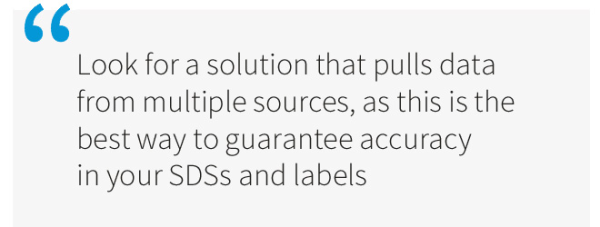This article is part of ERA’s three part series on GHS Hazard Classification. Part two highlights the importance of using multiple, reliable sources of chemical information to author your SDSs.
 When it comes to the Globally Harmonized System (GHS), having information is power. Information is what will power your ability to classify materials properly, author accurate Safety Data Sheets (SDSs) and labels, train your staff how to understand chemical hazards, and implement the GHS standards as efficiently as possible.
When it comes to the Globally Harmonized System (GHS), having information is power. Information is what will power your ability to classify materials properly, author accurate Safety Data Sheets (SDSs) and labels, train your staff how to understand chemical hazards, and implement the GHS standards as efficiently as possible.
However, right now there is a glut of information about the GHS and GHS classifications - the rabbit hole of information you could read is endless and it’s possible you might find yourself feeling more confused and conflicted than when you started. In fact, there is so much information available online right now that even some regulatory bodies and big businesses have their own unique interpretation of how the GHS Classification system works.
That’s why reliability is paramount when you’re assessing information about your chemicals and classifications so that you can author GHS-compliant labels and SDSs. Using the wrong information for the situation could result in an inaccurate and dangerous SDS.
Worse yet, you generally won’t discover an SDS is unreliable until it causes an employee injury or an onsite incident. Mistakes in your SDSs or labels could have significant consequences but are generally easily avoided with a little research.
How to Ensure Your SDSs & Labels are Accurate
The best method to ensure accuracy and reliability in any GHS-compliant material you produce is to take a two-tiered approach: first have the most accurate raw chemical data about your materials and, second, reference and compare multiple regulatory resources before making any final determinations.
The key here is balance: taking information from one regulatory list to make your classifications leaves you vulnerable to incorrect assumptions, but consulting every available list for each chemical will take days to author a single SDS. What works best is consulting around three to five trustworthy sources, and using those same sources each time.
For example, ERA Environmental Management Solutions authors SDSs and labels for chemical materials using at least four different databases of chemical determinations, chemical testing data, and regulatory body finds per chemical. ERA also breaks each material down into its exact chemical components so that SDSs have all the information they need.
The GHS doesn’t require chemical manufacturers or distributors to test each and every chemical and material that they ship or sell, instead allowing them to use industry publications that review lab testing data others have performed. If you’re using published testing data it’s especially important that you ensure the publication is credible.
Although you may find credible chemical data through your searches, the best sources are those sanctioned by or curated by an official government or regulatory body. For example, the Environmental Protection Agency (EPA) collects reliable data on chemical toxicity and environmental impacts.
Most important, always refer back to the United Nations’ “Purple Book”, which is the official guideline to GHS implementation. You can order a physical copy for your business online, or read it for free online here: http://www.unece.org/trans/danger/publi/ghs/ghs_rev03/03files_e.html

Raw chemical component data is the foundation of your SDSs and labels. If you know which chemicals make up your materials, you have the essential building blocks to classify your chemical hazards and assign proper precautionary statements. If you get your materials from a vendor and need to author labels for containers you use on site, take the extra step to ensure you are given reliable chemical component data from your vendors. Ideally, you should collect all your data from vendors electronically using a secure upload system to encourage higher quality data being shared with you.
Finding Tools for Accurate & Reliable Authoring
Right now businesses have a lot of options when it comes to GHS implementation. Classifications can be done in-house, you can hire consultants to do your authoring for you, or you can use a GHS software platform to author and manage your SDSs and labels online.
Regardless of which option you choose, it is essential that you assess their methodology for classifying material under the new GHS standards. How many sources do they reference when making a determination? How do they measure the reliability of those sources? Is there a dedicated research team knowledgeable about the many sources of information about the GHS?
Look for a solution that pulls data from multiple sources, as this is the best way to guarantee accuracy in your SDSs and labels. Extensive library and testing research should be done on each chemical component to ensure hazard classifications are correct. Doing this in-house gives you complete control of how much research gets done, but also requires a far greater time investment. Using a GHS software platform like ERA’s allows your authoring to rapidly cross reference multiple reliable sources, producing a SDS or label in just minutes. To learn more about the back-bone of hazard classification as well as the most effective way to become GHS Compliant, check out ERA's ultimate GHS Hazard Classification Guide.
Ask an ERA Expert:
Are you transitioning to the GHS in your business? Do you have any questions or concerns about the topic covered in this article? Want more insight? Now is your chance to ask one of ERA’s Environmental Specialists. Please leave your question or comment below and we’ll make sure one of our expert scientists responds.
|
Ask our SDS Specialist: Fulvio DeSantis is an SDS Authoring and Management expert at ERA Enviromental. If you have any questions about your GHS transition or SDS upkeep contact Fulvio at fulvio.desantis@era-ehs.com |
(Photo Credit: Oregon OSHA's HazCom)
This Blog was Co-Authored By:


May 22, 2014


Comments